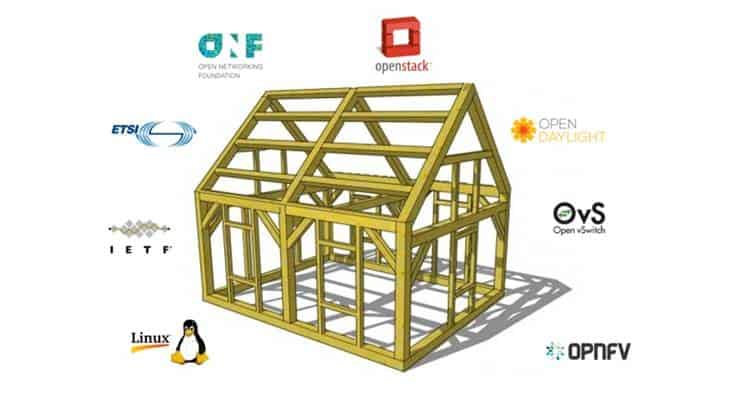The telecom sector is undoubtedly poised to push for more technological enhancements - on software and hardware ends - as demand for data and mobile services, specifically digital services continuous to grow. Amid the many changes that are taking place across various network functions, open networking and traffic intelligence is set to experience some of the most significant growth, with telcos expected to speed up initiatives and deployments in these areas. The following trends discuss what lies ahead:
#1: THERE WILL BE A SHIFT IN VALUE TO OPEN ARCHITECTURES, AUGMENTED WITH VALUE-ADDED EXTENSIONS
Future networks will be built using components linked by interfaces: standards and open source projects will form the framework of a new, open network architecture. There will be a shift in value from closed software and hardware to 1) maintenance, support and integration of open source software, 2) standard-based hardware, and 3) value-added commercial extensions.
For components from different suppliers to work, they will need to be interlinked with standardized interfaces defined in standards organizations such as ETSI, ONF, and IETF. In addition, the new component-based architecture will be structured around open source software (e.g. OpenStack as a resource orchestrator, OpenDaylight as a network controller, etc.). In this way, pragmatic and community-driven open source development will complement the slower and more formal standardization process.
-
What are the benefits of this new network architecture for service providers?
- Technical flexibility: interchangeable component products, efficient blend of open source and commercial products
- Commercial flexibility: fast & easy deployment of new services, optimized costs
Erik Larsson,
VP, Marketing,
Qosmos

#2: TELCOS WILL BE ABLE TO BETTER MONETIZE SERVICES, THANKS TO VCPE WITH SERVICE DYNAMIC CHAINING
In order to increase profitability and compete effectively, especially against cloud service providers and over-the-top (OTT) services companies, telcos are looking to reduce costs, simplify customer infrastructure and increase service agility.
One way to achieve this is through support of virtual customer premise equipment (vCPE) as a new service delivery architecture. With vCPE, the carrier installs basic customer premise equipment (CPE) at the subscriber site, and delivers more advanced CPE service functions from a data center in a central office, point of presence (PoP) or other central location.
Virtual CPE is an alternative way of delivering broadband services to subscribers, where most of the CPE functions are delivered from network and located near the service edge. In this new network architecture, the on-premise CPE acts as a simple layer 2 forwarding device that helps a business or residential subscriber to physically connect their network to the communication service provider network. Services such as DHCP, firewall, NAT, routing, VPN, etc. are delivered by virtual network functions (VNFs) running at the telco’s data center as a virtual machine (VM) instance configured for each broadband subscriber.

A service classifier optimizes the number and sequence (chain) of services delivered to premises, based on real-time application and subscriber information. The classifier can be configured using reference controller implementations such as OpenDaylight SFC for service function chaining. It is a standards-based, pure software product that colors IP traffic with application-awareness, using the upcoming IETF network service header (NSH) service chain header tagging standard, or existing type of service (ToS) differentiated services code point marking, VLAN tagging, or others.
2016 Trends and Outlook Polls
#3: FUTURE TELCO DATA CENTERS WILL BENEFIT FROM REAL-TIME LAYER 7 INTELLIGENCE ACROSS THE ENTIRE INFRASTRUCTURE
Future telco data centers will be completely service-aware, with real-time intelligence up to layer 7 available uniformly across the entire infrastructure.
Imagine replacing all Deep Packet Inspection (DPI) software residing in point products with IP classification software embedded in the hypervisor in each server. This means that traffic intelligence becomes a shared, uniform resource which can be used by all applications and L4-7 functions such as routers, switches, load balancers, application delivery controllers, firewalls, IPS, etc.
Technically, the classification software is integrated with the vSwitch and provides real-time, detailed understanding of traffic up to OSI layer 7, creating full service-awareness across the data center.
-
The benefits for data center operators:
- Easier capacity planning and optimization of equipment
- Generally reduced Opex and Capex, thanks to reduced compute needs
- Extended lifetime or lower cost for equipment such as switches (don’t need DPI inside)
- More effective system management thanks to uniform, consistent format of layer 7 intelligence so that traffic is always treated the same way across the network

The industry is showing high interest for several use cases: capacity planning, security, SLA monitoring, QoS and bandwidth optimization.
The winning combination for 2016 is open networking + traffic intelligence!
About The Author:
Erik drives all aspects of marketing for Qosmos, including product strategy, product marketing, demand generation, branding and communication. Prior to Qosmos, he led marketing for Netcentrex (acquired by Comverse), and managed marketing for Web hosting provider Integra (now Level 3). His previous experience includes several international marketing roles at Nortel. Erik’s views on high-tech trends are regularly featured in articles, blog posts, webcasts, video interviews, and industry events. He holds a MSc in Engineering Physics from KTH (Sweden) and an MBA from the Kelley School of Business at Indiana University (USA).



















